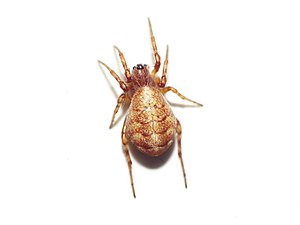Cross spider
| Cross spider | ||||||||||||
|---|---|---|---|---|---|---|---|---|---|---|---|---|

Cross spider ( Cercidia prominens ), female |
||||||||||||
| Systematics | ||||||||||||
|
||||||||||||
| Scientific name | ||||||||||||
| Cercidia prominens | ||||||||||||
| ( Westring , 1851) |
The earth cross spider ( Cercidia prominens ), also known as the heather circle spider , is a spider from the family of real orb web spiders ( Araneidae ). It is widespread in the northern hemisphere .
features
The females of the cross spider have a body length of about six millimeters, the males remain slightly smaller and reach four to five millimeters in length. The basic color of the cross spider is red-brown. The abdomen ( opisthosoma ) is lightened yellowish towards the front in the middle, especially in males this mark is often visible as a light central stripe. Darker horizontal stripes often result in a cross shape with a narrow median stripe of the same color. The abdomen is at the front end, towards the transition to the prosoma, almost triangularly pointed. On the two sides of the front abdomen there are also three to four pointed thorns, by which the species can usually be easily distinguished from similar species.
Occurrence
The cross spider is widespread across Europe, it is also found in Russia as far as the Far East and in the Caucasus as well as in Kazakhstan in Central Asia . It is also common in North America.
Their preferred habitats are both moist and dry areas with low vegetation, such as heathlands and forest edges. The cross spider is probably not uncommon there, but it is difficult to spot because of its camouflage color and its hidden way of life. It is not found in the mountains, but also occurs in dry places in moors.
Way of life
The cross spider builds her only about five to six centimeters large orb web at a height of five centimeters between grasses or herbs. It usually sits on the network hub and drops to the ground immediately in the event of a fault. Adult animals of the cross spider can be found all year round.
Systematics and taxonomy
The cross spider was first described in 1851 by Niklas Westring under the name Epeira, together with many other new spider species . It was later placed in the genus Cercidia Thorell, 1869. In this genus there are two other species in addition to the cross spider Cercidia prominens : Cercidia levii Marusik, 1985 and Cercidia punctigera Simon, 1889.
gallery
Individual evidence
- ↑ a b Heiko Bellmann : The cosmos spider guide. Over 400 species in Europe. Kosmos Naturführer, Kosmos (Franckh-Kosmos), 1st edition, 2010, pp. 152–153 ISBN 978-3-440-10114-8
- ↑ Cercidia_prominens in the Spinnen-Forum-Wiki, accessed on March 13, 2019
- ↑ a b Cercidia prominens at Araneae - Spiders of Europe, accessed on March 13, 2019
- ↑ Bodo v. Broen and Manfred Moritz: Contributions to the knowledge of the arachnid fauna of northern Germany. I. About the maturation and reproduction time of the spiders (Araneae) and harvestmen (Opiliones) in a moor area near Greifswald. German Entomological Journal, 10, 3–5, 1963
- ^ Hermann Wiehle: Further contributions to the biology of the Araneen, in particular to the knowledge of the construction of the cycle network. Journal for Morphology and Ecology of Animals, 15, 1–2, 1929, p. 278.
- ↑ Niklas Westring : Förteckning öfver de till närvarande tid Kände, i Sverige förekommande Spindlarter, utgörande ett antal af 253, deraf 132 aro nya för svenska Faunan. Göteborgs Kungliga Vetenskaps och Vitterhets Samhälles Handlingar 2, pp. 25–62, 1851 (first description)
literature
- Niklas Westring : Förteckning öfver de till närvarande tid Kände, i Sverige förekommande Spindlarter, utgörande ett antal af 253, deraf 132 aro nya för svenska Faunan. Göteborgs Kungliga Vetenskaps och Vitterhets Samhälles Handlingar 2, pp. 25–62, 1851 (first description)
- Heiko Bellmann : The cosmos spider guide. Over 400 species in Europe. Kosmos Naturführer, Kosmos (Franckh-Kosmos), 1st edition, 2010, pp. 152/53 ISBN 978-3-440-10114-8


